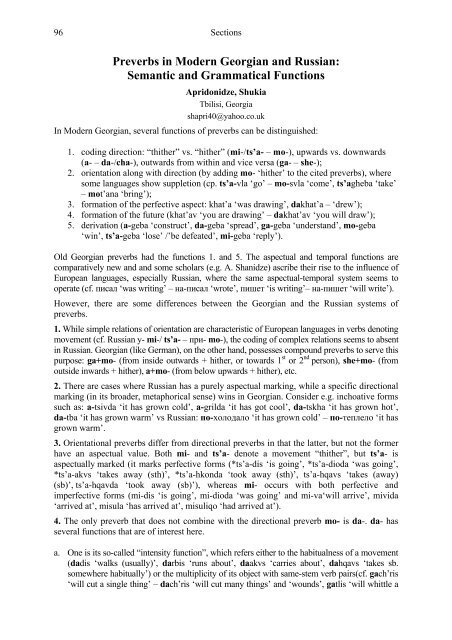Relativism and Universalism in Linguistics - Fachbereich 10 ...
Relativism and Universalism in Linguistics - Fachbereich 10 ...
Relativism and Universalism in Linguistics - Fachbereich 10 ...
Create successful ePaper yourself
Turn your PDF publications into a flip-book with our unique Google optimized e-Paper software.
96 Sections<br />
Preverbs <strong>in</strong> Modern Georgian <strong>and</strong> Russian:<br />
Semantic <strong>and</strong> Grammatical Functions<br />
Apridonidze, Shukia<br />
Tbilisi, Georgia<br />
shapri40@yahoo.co.uk<br />
In Modern Georgian, several functions of preverbs can be dist<strong>in</strong>guished:<br />
1. cod<strong>in</strong>g direction: “thither” vs. “hither” (mi-/ts’a- – mo-), upwards vs. downwards<br />
(a- – da-/cha-), outwards from with<strong>in</strong> <strong>and</strong> vice versa (ga- – she-);<br />
2. orientation along with direction (by add<strong>in</strong>g mo- ‘hither’ to the cited preverbs), where<br />
some languages show suppletion (cp. ts’a-vla ‘go’ – mo-svla ‘come’, ts’agheba ‘take’<br />
– mot’ana ‘br<strong>in</strong>g’);<br />
3. formation of the perfective aspect: khat’a ‘was draw<strong>in</strong>g’, dakhat’a – ‘drew’);<br />
4. formation of the future (khat’av ‘you are draw<strong>in</strong>g’ – dakhat’av ‘you will draw’);<br />
5. derivation (a-geba ‘construct’, da-geba ‘spread’, ga-geba ‘underst<strong>and</strong>’, mo-geba<br />
‘w<strong>in</strong>’, ts’a-geba ‘lose’ /’be defeated’, mi-geba ‘reply’).<br />
Old Georgian preverbs had the functions 1. <strong>and</strong> 5. The aspectual <strong>and</strong> temporal functions are<br />
comparatively new <strong>and</strong> <strong>and</strong> some scholars (e.g. A. Shanidze) ascribe their rise to the <strong>in</strong>fluence of<br />
European languages, especially Russian, where the same aspectual-temporal system seems to<br />
operate (cf. писал ‘was writ<strong>in</strong>g’ – на-писал ‘wrote’, пишет ‘is writ<strong>in</strong>g’– на-пишет ‘will write’).<br />
However, there are some differences between the Georgian <strong>and</strong> the Russian systems of<br />
preverbs.<br />
1. While simple relations of orientation are characteristic of European languages <strong>in</strong> verbs denot<strong>in</strong>g<br />
movement (cf. Russian у- mi-/ ts’a- – при- mo-), the cod<strong>in</strong>g of complex relations seems to absent<br />
<strong>in</strong> Russian. Georgian (like German), on the other h<strong>and</strong>, possesses compound preverbs to serve this<br />
purpose: ga+mo- (from <strong>in</strong>side outwards + hither, or towards 1 st or 2 nd person), she+mo- (from<br />
outside <strong>in</strong>wards + hither), a+mo- (from below upwards + hither), etc.<br />
2. There are cases where Russian has a purely aspectual mark<strong>in</strong>g, while a specific directional<br />
mark<strong>in</strong>g (<strong>in</strong> its broader, metaphorical sense) w<strong>in</strong>s <strong>in</strong> Georgian. Consider e.g. <strong>in</strong>choative forms<br />
such as: a-tsivda ‘it has grown cold’, a-grilda ‘it has got cool’, da-tskha ‘it has grown hot’,<br />
da-tba ‘it has grown warm’ vs Russian: по-холодало ‘it has grown cold’ – по-теплело ‘it has<br />
grown warm’.<br />
3. Orientational preverbs differ from directional preverbs <strong>in</strong> that the latter, but not the former<br />
have an aspectual value. Both mi- <strong>and</strong> ts’a- denote a movement “thither”, but ts’a- is<br />
aspectually marked (it marks perfective forms (*ts’a-dis ‘is go<strong>in</strong>g’, *ts’a-dioda ‘was go<strong>in</strong>g’,<br />
*ts’a-akvs ‘takes away (sth)’, *ts’a-hkonda ‘took away (sth)’, ts’a-hqavs ‘takes (away)<br />
(sb)’, ts’a-hqavda ‘took away (sb)’), whereas mi- occurs with both perfective <strong>and</strong><br />
imperfective forms (mi-dis ‘is go<strong>in</strong>g’, mi-dioda ‘was go<strong>in</strong>g’ <strong>and</strong> mi-va‘will arrive’, mivida<br />
‘arrived at’, misula ‘has arrived at’, misuliqo ‘had arrived at’).<br />
4. The only preverb that does not comb<strong>in</strong>e with the directional preverb mo- is da-. da- has<br />
several functions that are of <strong>in</strong>terest here.<br />
a. One is its so-called “<strong>in</strong>tensity function”, which refers either to the habitualness of a movement<br />
(dadis ‘walks (usually)’, darbis ‘runs about’, daakvs ‘carries about’, dahqavs ‘takes sb.<br />
somewhere habitually’) or the multiplicity of its object with same-stem verb pairs(cf. gach’ris<br />
‘will cut a s<strong>in</strong>gle th<strong>in</strong>g’ – dach’ris ‘will cut many th<strong>in</strong>gs’ <strong>and</strong> ‘wounds’, gatlis ‘will whittle a

















